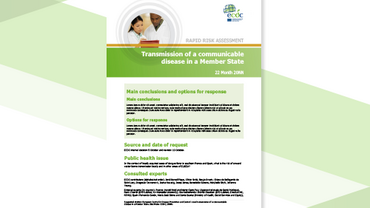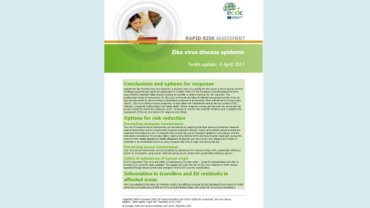Rapid Risk Assessment: Zika virus infection outbreak, Brazil and the Pacific region, 26 May 2015
This is the first documented outbreak of Zika virus (ZIKV) infection in Brazil and the Americas.
Imported ZIKV cases are possible in EU Overseas Countries and Territories and the EU Outermost Regions, with onwards autochthonous transmission where potential vectors are present. Autochthonous transmission in EU Members States in continental Europe, arising from imported cases during the summer season in areas where Aedes albopictus are established, cannot be excluded.
Executive Summary
Vigilance should be enhanced towards the detection of imported cases of Zika virus (ZIKV) infection in EU Member States, EU Overseas Countries and Territories, and EU Outermost Regions, in particular where potential vectors are present. This is the main conclusion of the ECDC risk assessment published today. Early detection of cases is essential to reduce the risk of autochthonous transmission in regions where potential vectors are established.
The risk assessment also highlights that clinicians and travel medicine clinics should be aware of the evolution of ZIKV-affected areas in Brazil and the Pacific region and should include ZIKV infection in their differential diagnosis for travellers from those areas. Fever and/or macular or papular rash not attributable to dengue or chikungunya infection among travellers returning from areas currently experiencing ZIKV outbreak should prompt further investigation for ZIKV infection.
Autochthonous transmission in EU Members States in continental Europe, arising from imported cases during the summer season in areas where Aedes albopictus are established, cannot be excluded. Blood safety authorities need to be vigilant regarding the epidemiological situation and might wish to consider deferral of donors with relevant travel history, in line with measures defined for West Nile virus.
Exposure to infected mosquitoes is the principal risk for infection. Prevention of ZIKV infection is based on protection against mosquito bites and vector control, particularly for travellers visiting affected areas.
On 15 May 2015, the Ministry of Health of Brazil confirmed the circulation of ZIKV in the country following the identification of ZIKV in 16 samples (eight from Bahia and eight from Rio Grande do Norte) by the National Reference Laboratory. The Ministry of Health is investigating other suspected cases of rash and has strengthened surveillance, prevention and control measures in the country. This is the first report of autochthonous ZIKV infection in Brazil. In 2015, the Department of Health in Vanuatu reported an unspecified number of confirmed cases of ZIKV. In the Solomon Islands, an outbreak has been ongoing since February 2015, probably linked to recent outbreaks in other Pacific Island countries. As of 20 May 2015, the Direction des Affaires Sanitaires et Sociales de Nouvelle-Calédonie has reported 82 confirmed cases of ZIKV disease in New Caledonia since 1 January 2015.
About Zika
Zika is a mosquito-borne viral disease caused by Zika virus (ZIKV), initially identified in 1947 in the Zika forest in Uganda in the Rhesus macaque population. The main clinical symptoms in patients are low-grade fever (< 38.5 °C), transient arthritis/arthralgia with possible joint swelling (mainly in the smaller joints of the hands and feet) and maculo-papular rash (that often starts on the face and then spreads throughout the body), conjunctival hyperaemia or bilateral non-purulent conjunctivitis with general non-specific symptoms such as myalgia, asthenia and headaches. Clinical symptoms of Zika disease appear after an incubation period ranging between 3 and 12 days. The disease symptoms are usually mild and short lasting (2–7 days), and infection may go unrecognised or be misdiagnosed as dengue.







